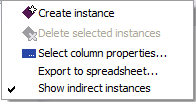A super convenient feature of TopBraid Composer is the capability to manage and manipulate triples. You can drag a statement from one resource and copy onto another, or a selected group. This saves lots of repetitive work. Yet another reason TBC is my favorite ontology editor.
It is so convenient and you quickly become so dependent on the feature that you start wishing that you could remove triples from a group of resources in the same way. Triples are always additive in these scenarios, they can only add information and not remove it. Thus the need for an anti-triple, a triple that represents anti-information.
This could simply be a triple that is flagged to have a negative sign, so when dropped onto a resource it remove an occurrence of itself -or the pattern it represents. Thought of another way, when a triple meets an anti-triple in an ontological space, they annihilate each other.
I'm thinking of anti-triples as an editing paradigm of convenience of course. For instance a triple could be dropped onto a resource with the "-" key held down to take the deletion action.
Of course Anti-Triples recognized in a future OWL revisions could lead to anti-ontologies of a anti-knowledge, which would no doubt be abused by black-hats for information espionage and evil doing. Eventually getting fully out of hand by a mad scientist bent on the uncreation of the Semantic Web lest our hero reaches the glowing red off button in the control room in the base of the hollowed out volcano which has just decided to conveniently erupt.
Time to write a screen play... maybe the Semantic Web will lead to a revival of all the cheezey "net" movies and television shows of the late 90s. Will semantics make the net-cheeze-flicks any more intelligent this time around?
 Only problem was he couldn't recall how he enabled the feature and it wasn't an option in the Window > Preferences > TopBraid Composer list. I stumbled into it under the "Instances" window options. Its the last option with the label "Show indirect instances":
Only problem was he couldn't recall how he enabled the feature and it wasn't an option in the Window > Preferences > TopBraid Composer list. I stumbled into it under the "Instances" window options. Its the last option with the label "Show indirect instances":